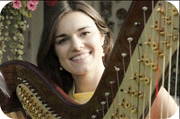Tutor HuntResources Harp Resources
Tips On How To Practice The Harp
Date : 25/09/2015
Author Information

Uploaded by : Megan
Uploaded on : 25/09/2015
Subject : Harp
A goal has been set by the teacher: to learn the notes at half speed by the next lesson. This task may seem daunting at first so, to make it seem more achievable you could split the piece into different sections. The student will then be able to dedicate an hour or two per day to a different passage.
Starting at the last segment of the piece and working backwards will make segments seem much clearer. Also, the end tends to be the hardest part of the piece so being able to practice this section at the very start will make other sections seem easy. Searching for melodic and harmonic patterns in the piece, will help you get to know the notes quicker.
After analysing the score visually, it's now time to physically practice the piece. Firstly, I would set the metronome at the advised speed and practice each section with both hands separately, dedicating your full concentration to one movement at a time. Practicing loudly is also beneficial at the beginning. As you are exaggerating every movement, the muscles get to know exactly what they're doing. It's true that repeating a small segment numerous times can make you learn the notes quicker; however, it can be tedious and the pupil could lose interest. Therefore, I would show them a variation of practice procedures that could keep them interested and motivated whilst repeating sections.
Memorization should be a procedure that takes place alongside your first practice session. Learning details such as correct fingering from the very beginning will give the pupil a head start on memorization as it will save time changing incorrect fingerings. This kind of memory is known as kinaesthetic memory and it depends on physical movements.
Some learners can be visual learners and they are able to use their visual or "photographic" memory of the score when performing. Mental practice is an efficient way of visually memorizing music and it can be done by looking at the score and taking in every detail. Another advantage is that it can be done whilst having a break from physical practice, allowing the muscles to relax for a while.
The Kodály Method is an approach to music education and its creator, Zoltán Kodály, was a firm believer in using aural skills to develop musicianship, as quoted below.
"We should read music in the same way that an educated adult will read a book: in silence, but imagining the sound" -Zoltan Kodaly
Some learners use their aural memory by singing the melody in their head. If possible, I would recommend the student to sing the melody whilst practicing. Not only will this help whilst memorizing but also to accentuate the ebb and flow of the melody and help shape the piece.
This resource was uploaded by: Megan
